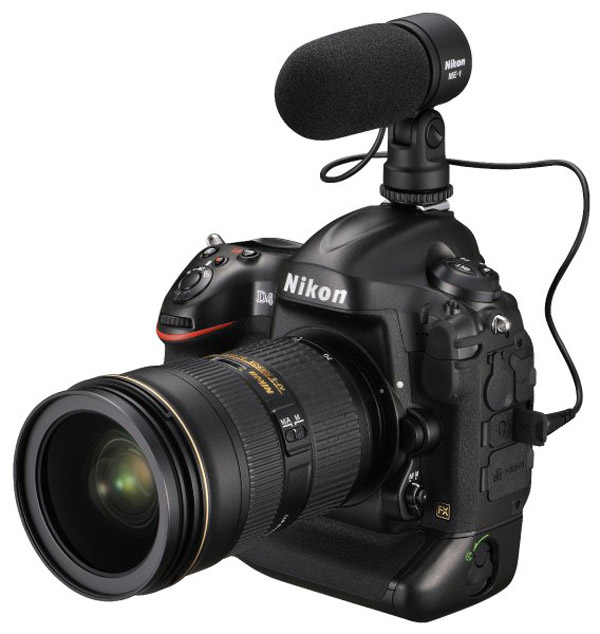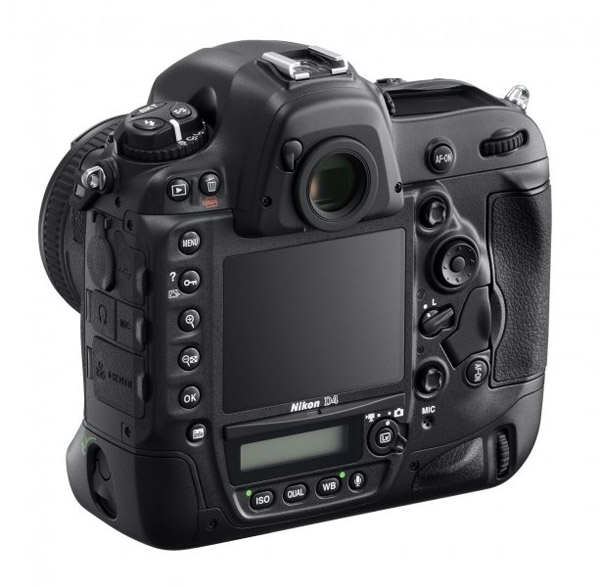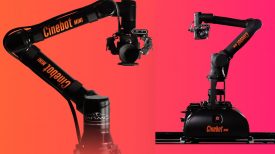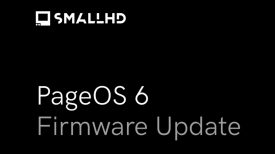By Dan Chung
Many people forget it was the Nikon D90 that started the DSLR video revolution. It predated the launch of the Canon 5D mkII by several months. Sadly Nikon didn’t take the lead in DSLR video, instead leaving Canon to rule the roost. Nikon have put video into their recent DSLR cameras, notably the D7000 and D3s, but the image quality of the footage was frankly not as good as the competition (except that the D3s did do very well in low light). All this might be about to change with the launch of the D4. Nikon have finally given DSLR video users some of their most requested features.
In terms of video the D4 can shoot full 1080p or 720p at 29.97, 25 and 24.98 frames a second (fps). It can also shoot standard def 640×480 at 30 or 25 fps. Interestingly, according to Dpreview, it crops the output of the video in FX full frame mode to 91% of its sensor width (I’m not sure why Nikon have done this and I’m trying to find out). Rolling shutter and skew is said to be improved over previous Nikons.
Capture time is limited to a strangely arbitrary 20 minutes in 1080P Highest quality – I have no idea why this might be. I assume this has something to do with file size. Hopefully you can restart recording immediately but this too needs to be tested. In other modes is can record for 29 minutes 59 seconds.
Audio is the main leap forward in the D4. Along with a regular 3.5mm mic input jack there is also a headphone jack – a first for a DSLR and a feature I have been wanting to see since the Canon 5D mkII first landed in my hands. The level of the headphone output can be adjusted. There are also on-screen audio level meters and the recording level can be adjusted manually in 20 steps. The quality of the mic input also needs to be tested out.
As well as manual focus you can autofocus in video mode. Again details are scarce but Nikon claim it is faster than the D3s and you can use face detection if you feel the need to. Before recording you can magnify the image to confirm focus but not during recording – similar to other DSLRs.
The D4 records to either CF or the new XQD memory card using H.264 encoding at 24Mb/s with B-frame compression. How good this will look compared to the much higher bitrates from Canon’s 1D X using I-frame compression will be interesting to see. For web video – as well as news photographers just grabbing a quick video clip – it will easily be good enough. For higher quality, Nikon has another trick up its sleeve – uncompressed HDMI output from the camera for higher bitrates and better quality. Better still, you can have the camera’s rear LCD active whilst still sending video out of the HDMI port. At this stage all I know is that the signal is a 1080i one that supposedly outputs at 8 bit at 4:2:2. I do know that Nikon have demonstrated this working with an Atomos Ninja external HDMI recorder. It is also unclear if Nikon have any log type tone curves that are applicable to this output. Audio is passed out on the HDMI. It will be interesting to see just how good the image from the D4 really is when fed to an external recorder.
Nikon have also introduced crop sensor shooting which allows different fields of view with the same lens. Utilising the fact that the sensor has over 16 millions pixels this feature is similar to the ETC mode on a Panasonic GH2 and effectively gives you a digital telephoto effect without much too loss in quality. There are both DX (approx 1.5x crop) and 2.7x (actual 1 to 1 pixel) crop modes. The DX crop mode in particular will be of use allowing lenses like the Nikon 17-55 f2.8 and 12-24mm f4 which are designed for that sensor size to be used. The 2.7x crop will be useful in news situations where even your longest lens isn’t long enough to fill the frame.
Video can be triggered using the shutter button, the dedicated video button or – importantly – an electronic cable release. This is similar to the Canon 1D X and makes for much easier triggering on rigs and when you install the camera in remote places. If you add the new WT-5 wireless transmitter there will be even more remote control options with the possibility of iPad/iPhone control, you can set most functions but again controls can’t be adjusted when recording starts.
Exposure has seen improvements for video too. You can adjust the aperture, shutter speed and ISO manually as with other cameras. Aperture can now be controlled using the new ‘Power aperture’ feature in 1/8 stop increments using buttons on the camera before shooting. Strangely this is disabled once recording starts and you are back to using 1/3 stop increments on the camera’s control dial.
With fully featured large sensor video cameras like the Canon C300, Sony F3 and FS100 gaining popularity I don’t think there are too many purely video shooters who will be looking to buy a Pro DSLR costing $6000 (although I may be proved wrong). If on the other hand you are a photographer first and foremost, but also shoot video, then cameras like the D4 are welcome option. News agencies like Agence France Press who already use the D3s for video reporting should benefit a lot from the D4.
Choosing between Canon’s 1D X and the D4 will be interesting. The D4 clearly has more video oriented features but the 1D X is no slacker either. I wait to see image comparisons and field tests of the two cameras side by side.
Below is a preview video from What Digital camera.
Here’s the full press release from Nikon:
The Nikon D4 – Built to push limits
RRP: ££4,799.99 / €5,658
Sales start date: 16th February 2012 (tbc)
London, UK, 6th January 2012: Nikon today announces the launch of the D4, its new flagship D-SLR for photographers who are looking for the ultimate digital SLR camera to revolutionize photography.
Designed to push the limits and realize every shooting opportunity, this new professional FX-format camera brings new levels of image quality, speed and precision to both still photography and video.
Equipped with a 16.2-megapixel FX-format sensor, phenomenally high ISO and Nikon’s powerful EXPEED3 image processing engine, the new model offers uncompromised performance and unrivalled versatility in extreme lighting and environmental conditions.
“The introduction of the Nikon D4 sets a new benchmark for photography,” says Kentaro Kusakari, Product Planning Manager, Nikon UK. “We’re proud to be launching a new flagship model that exceeds the capabilities of its world renowned predecessor, the Nikon D3. This new camera has been designed for class leading professionals looking to push the limits of photography and improve their workflow. We’re confident that the Nikon D4 will help take them to the next level.”
Uncompromised Image quality—Exceptional speed
Engineered to deliver remarkable image integrity in the most diverse lighting conditions, the D4 offers blisteringly fast fps performance and sets a new benchmark in low-noise performance. The 16.2 megapixel FX-format (full-frame) CMOS sensor with fast channel readout delivers up to 11 fps—faster than any other Nikon DSLR camera.
Images of remarkable quality with low noise and wide dynamic range can be realized even at high ISO sensitivities thanks to the optimized noise reduction design and 14-bit A/D signal processing built into the sensor. The phenomenal ISO range sets a new benchmark of ISO12800 and extends the range one EV further to make ISO 100 a standard. For more challenging conditions, equivalent ISO 50 and ISO 204,800 sensitivities make the D4 the camera of choice for photographers who typically face extreme lighting challenges.
Super-charged EXPEED3 image processing engine
Thanks to Nikon’s next-generation EXPEED 3 image-processing engine, the D4 makes light work of multiple data-rich tasks without sacrificing the speed and quality that pros are accustomed to. High-speed 16-bit image processing follows the 14-bit A/D conversion to deliver submission-ready JPEGs straight out of the camera. Performance is never compromised, even when undertaking the most data-intensive tasks. Images boast faithful, well-saturated colour and natural depth. Even when shooting in dim lighting at high ISO sensitivities, the camera’s intelligent, performance-proven noise reduction lowers noise without degrading image sharpness.
Broadcast quality video
For professionals whose workflow demands video, the D4 offers all the flexibility required for a wide variety of movie applications. It’s large format movie shooting at its best, with a comprehensive variety of frame rates.
Frame rates: Full HD (1080p) movies can be recorded in 30p, 25p and 24p, with 60p, 50p, 30p and 25p options at 720p. Movie clips can be close to 30 minutes long (approx. 29.59 min).
Multi-area mode: Full HD (1080p) recording is possible in both FX and DX based formats as well as in native Full HD (1920×1080) crop.
High-fidelity audio control: responding to feedback from the industry, the D4 introduces new possibilities for D-SLR audio recording that enable your movies to sound as good as they look. Aside from the external stereo microphone input, an audio out for external headphones lets you fine tune audio in isolation.
Uncompressed HDMI output: for those who need the purest video output for professional quality editing, the D4 offers the possibility to output the uncompressed live view to external recorders and monitors. The first time this has been possible in an SLR camera, data is output at 1080i (Full HD) at the designated image size and frame rate. Data output can be scaled down if necessary and is clean of the information overlay that can be simultaneously displayed on the camera’s TFT monitor.
Convenient custom controls: live view operation is enhanced thanks to convenient custom controls. Instead of rotating the command dial, power aperture enables smoother aperture control via assigned buttons on the front of the camera. Index marking enables important frames to be tagged in the timeline during movie recording, which makes for easy location during editing.
New levels of speed and accuracy
When it comes to nailing decisive moments, the D4’s enhanced auto operation gives photographers a clear advantage.
Advanced scene recognition with 91K-pixel RGB sensor: Nikon’s revolutionary Advanced Scene Recognition System now incorporates the newly designed 91,000-pixel RGB sensor that meticulously analyses each scene for outstanding accuracy.
3D-subject tracking is particularly improved when shooting and tracking smaller subjects. Human faces are detected with startling exactness even when working in real time through the optical viewfinder. This level of detailed scene analysis is also utilised to support more accurate autofocus and auto exposure, even under the most challenging lighting conditions.
Advanced Multi-CAM3500FX AF Sensor Module: Nikon’s highly acclaimed Multi-CAM 3500FX AF system —with individually selectable or configurable 9-, 21- and 51-point coverage settings — has been re-engineered for faster subject detection.
The autofocus sensor module and algorithms significantly improve low light acquisition sensitivity capabilities down to -2 EV (ISO 100, 20°C/68°F). All 51 focus type sensors are fully responsive with any AF NIKKOR lens f/5.6 and—for the first time—this superb performance does not end at f/5.6 apertures.
Powerful AF sensors compatible up to f/8: the D4 maintains the power of the eleven central AF sensors, including one cross-type even if the combined open aperture value is f/8. A big plus for shooting sports and wildlife, this delivers a new level of detection potential when combining, for example, a 600mm f/4 AF-NIKKOR lens with a NIKKOR 2.0x teleconverter. If the combined aperture value is between f/5.6 and f/8, you even have the power of fifteen central AF sensors available, of which nine are cross type sensors.
Faster total workflow speed
The D4’s speed runs across its entire workflow.
Newly developed Kevlar/carbon fiber-composite shutter unit: the new, highly durable shutter unit offers a standard life cycle rating of 400,000 releases, with a maximum shutter speed of 1/8000 to 30s and flash synchronization at up to 1/250 sec. An intelligent self-diagnostic shutter monitor and a drive unit reduce the demand on power when the shutter is raised for extended periods during movie shooting.
Fast response: start-up is approx. 0.12 seconds[1], release time lag is minimised to approx. 0.042 seconds[2] (equivalent to that of the D3S), with approx. up to 11 fps capability in FX-format and all crop modes.
Storage media: the D4 offers two card slots. One for high-speed CF (UDMA 7) cards and one for high-speed, high-capacity XQD card slot.
Connectivity: a powerful data communication and control system makes both wired and wireless LAN file transfer faster and easier than ever. Wireless LAN support is available via the compact, newly designed WT-5 Wireless Transmitter, which features HTTP and FTP connection modes and also allows for the simultaneous release of several cameras equipped with WT-5. HTTP mode has also been designed to work with iPhone screen resolutions. For the first time in a Nikon camera, a wired LAN connection is integrated into the camera body.
Always up to the job
Every millisecond can count, and the D4’s improved operability helps photographers respond quickly to changing situations.
Intuitive horizontal and vertical control: each orientation has identically laid-out controls, conveniently placed so that the camera may quickly become an extension of your hand whether you shoot in landscape or portrait.
Simplified AF and AF-area mode selection: now possible without taking your eye away from the viewfinder.
Precision 8-cm (3.2-in.), approx. 921k-dot, wide-viewing-angle LCD monitor with automatic brightness control. The monitor delivers bright, crisp image playback with a much wider colour reproduction capacity. LCD brightness is automatically adjusted according to the viewing environment and images can be magnified up to 46x during playback, which can be a big help for spot focus confirmation.
Glass prism optical viewfinder: offers approximately 100% frame coverage and 0.7x magnification (50mm f/1.4 lens at infinity, -1.0m-1). The high eyepoint design of Nikon’s viewfinders is renowned for minimizing visual fatigue when using the camera for extended periods of time.
Dual-axis electronic virtual horizon: offers accurate confirmation of level shooting by letting you check the LCD monitor, or the viewfinder, for both the camera’s position in relation to the horizontal plane and its pitch (forward or rear rotation).
Direct access to Picture Controls: via a dedicated button, rather than the menu. Picture Controls let you customize the look of your stills and videos by fine-tuning parameters such as sharpness, saturation, and hue.
Complete control over workflow
The D4 is built for speed, but not for speed alone. Readiness and versatility go hand in hand with control options that can deliver a real advantage when time is of the essence.
Time-lapse movies: the D4 extends the popular time-lapse photography function by saving images as a movie file in the camera. With playback rates from 24 to 36,000 times faster than normal.
HDR (High Dynamic Range): shoots one overexposed and one underexposed frame in a single shutter release. The range can be widened by up to 3 EV for different looks, full of saturation and tonal gradation. The smoothness of the edge where the two exposures meet can be adjusted for a more natural look.
Refined colour temperature control: enables minute control over white balance. The monitor hue of live view and the resulting image’s white balance can be adjusted so that the two are aligned. Colour temperature can be manually set in 10-Kelvin increments, or in mired units.
Four image area options: you can choose from a variety of image crop modes, all visually masked in the viewfinder. 5:4 (30.0 x 24.0 mm), 1.2x (30.0 x 19.9 mm), and DX-format (23.4 x 15.6 mm).
In-camera editing: captured images and movies can be altered and edited in camera and on the fly if required. Retouch menus include an array of useful features such as NEF (RAW) processing, resize, distortion and perspective control just to name some of them. On top of that it has the ability to designate the start and end point of movie clips all at once, in order to save them more efficiently.
Accessories
Compact WT-5 Wireless Transmitter (optional): attaches to the camera’s designated interface connector and is powered by the camera body. It features HTTP and FTP connection modes and allows for the simultaneous release of several cameras equipped with WT-5.
GP-1 GPS unit (optional): records location information such as latitude, longitude, altitude and time (UTC) as ‘geotags’ in the image data (Exif) and allows simultaneous operation together with the WT-5.
Compact Stereo Microphone ME-1 (optional): records clear sound while significantly reducing mechanical noise.
Nikon SB-910 (optional)—Unparalleled lighting performance: offers versatile i-TTL for on-camera or wireless flash control, refined operability and a powerful guide number of 34/112 (ISO 100, m/ft, STD, FX format, zoom 35mm). Menus and controls have been improved for more operational ease. Hard-type incandescent and fluorescent colour filters are included, which can adjust your D4’s white balance instantly.
Capture NX 2 (optional)—Fast, powerful and creative image processing: to accommodate the imaging power of the D4, Capture NX 2 is faster than before and boasts full 64-bit compatibility.
Camera Control Pro 2 (optional)—Versatile remote camera controls: aside from controlling exposure mode, shutter speed, and aperture, this software now offers numerous improvements to make the D4’s live view operation exceptionally smooth. New creative controls include remote start and stop for movie shooting and the option to switch quickly between stills and movies in live view.
ViewNX 2 (supplied)—Browse, edit, share and more: bundled, all-in-one software implements an easy-to-use interface and an array of editing functions, including basic editing of RAW files and D-Movies. Seamlessly integrates with my Picturetown, Nikon’s photo sharing and storage service
ENDS








